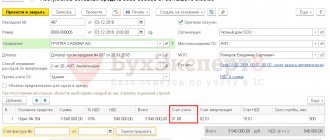Acceptance of real estate under the acceptance certificate
Costs for the acquisition of office space, which will subsequently be taken into account as a fixed asset (FPE), are reflected in account 08.04 “Purchase of fixed assets” (1C chart of accounts).
Real estate objects suitable for exploitation are accepted into the fixed assets regardless of the moment of transfer of ownership rights and are accounted for at their original cost in a separate subaccount to the fixed assets accounting account (clause 52 of the Guidelines for accounting of fixed assets, approved by Order of the Ministry of Finance of the Russian Federation dated October 13, 2003 N 91n, clause 7 PBU 6/01).
The initial cost of the fixed assets is formed based on the actual costs of its acquisition, delivery and bringing the object to a condition suitable for use (clause 8 of PBU 6/01, clause 1 of Article 257 of the Tax Code of the Russian Federation).
Find out more about the formation of the initial cost in BU and NU
In 1C there are two options for registering the acquisition and accounting of fixed assets:
Standard option , which uses documents:
- capitalization of fixed assets - document Receipt (act, invoice) type of operation Equipment ;
- commissioning of OS - document Acceptance for accounting of OS ;
Simplified version , which uses a single document:
- capitalization and commissioning of fixed assets - document Receipt (act, invoice) type of transaction Fixed assets .
Learn more about Options for registering an OS in 1C, as well as the capabilities and limitations of each method
Real estate objects are reflected on the balance sheet of the organization at the time of receipt of the primary documents for its transfer, regardless of the date of transfer of ownership rights (clause 52 of the Guidelines for OS accounting, approved by Order of the Ministry of Finance of the Russian Federation dated October 13, 2003 N 91n).
When registering a property for which ownership has not yet been registered, you can choose any method, but you must take into account other restrictions provided for the simplified option.
In our example, there are no restrictions for using the simplified version, so we will formalize the acceptance of fixed assets for accounting using a single document Receipt (act, invoice) transaction type Fixed assets in the section Fixed assets and intangible assets – Receipt of fixed assets – Receipt of fixed assets.
The header of the document states:
- The method of reflecting depreciation expenses is the method of accounting for the costs of depreciation of fixed assets, selected from the directory Method of reflecting expenses .
In our example, depreciation costs will be taken into account as general business expenses, since the property will be used as an office.
- Assets accounting group - Buildings .
- OS location - location of operation of the OS, selected from the Division directory.
- The Objects are intended for rental checkbox is not selected: in our example, the purchased object will be used for our own needs.
The tabular section indicates:
- Fixed asset is a purchased property that must be created in the Fixed Assets directory .
In the NU for used assets, the useful life is indicated with the exception of the service life of the previous owner (clause 7 of article 258 of the Tax Code of the Russian Federation).
- Service life - useful life (USI) for an object. In this document, only one SPI can be established - the same for NU and BU.
- Accounting account - 01.08 “Fixed assets in the organization”, it must be set manually;
- Depreciation account - 02.01 “Depreciation of fixed assets accounted for in account 01” will be set automatically.
When posting a document, the fixed asset card in the Fixed Assets will be filled out as follows PDF. In this case, the depreciation group will be determined automatically depending on the service life specified in the document.
In the fixed asset card for used fixed assets, in the Depreciation group of the Classification section for this object, you must indicate the depreciation group established by the previous owner (clause 12 of Article 258 of the Tax Code of the Russian Federation). If necessary, you need to adjust the depreciation group of the fixed asset.
The remaining data in the OS card is filled in manually.
Postings according to the document
The document generates transactions:
- Dt 08.04.2 Kt 60.01 - formation of the initial cost of the asset.
- Dt 01.08 Kt 08.04.2 - acceptance of a real estate object into the OS, the ownership of which has not been registered;
- Dt 19.01 Kt 60.01 - acceptance of VAT accounting.
Documenting
The organization must approve the forms of primary documents, including the document on commissioning of the property and the form of the inventory card for further accounting of fixed assets. In 1C, the Certificate of Acceptance and Transfer of a Building (Structure) OS-1a and Inventory Card OS-6 are used.
The form of the Certificate of acceptance and transfer of a building (structure) OS-1a can be printed by clicking the Print button - Certificate of acceptance and transfer of OS (OS-1) of the document Receipt (act, invoice) . PDF
The Inventory card form in the OS-6 form can be printed by clicking the OS Inventory card (OS-6) in the fixed asset card (section Directories - OS and intangible assets - Fixed assets). PDF
Transfer of rights to real estate
According to paragraph 2 of Art. 223 of the Civil Code of the Russian Federation and clause 1 of Art. 551 of the Civil Code of the Russian Federation, ownership rights arise at the time of state registration. The acceptance certificate only indicates that the transfer took place in practice. This can happen before or after registration.
Art. is of rather great importance here. 17 of the Registration Law, which indicates that the basis for the transfer of rights are contracts and other transactions, for example, a will, which is a unilateral transaction. Without this, it is impossible to register the transfer of rights to an immovable property.
Of the two documents, the agreement and the deed of transfer, the agreement takes precedence.
Moreover, in it the parties can indicate that the contract should be considered fulfilled without drawing up a transfer deed or other transfer document. This possibility follows from the very principle of freedom of contractual relations and Art. 224 Civil Code of the Russian Federation.
Reflection Art. 556 of the Civil Code of the Russian Federation as determined by the Supreme Court of the Russian Federation
In judicial rulings of the RF Armed Forces, art. 556 of the Civil Code of the Russian Federation has almost never been the main one. It is mentioned in conjunction with others that relate to the essence of the cases under consideration. One of the examples that reveals the essence of the acceptance certificate is the ruling in case No. 5-KG 14-24, which was considered on May 13, 2014. The article we are interested in was mentioned in it due to the fact that the board considered it necessary to emphasize its relation only to purchase and sale transactions, and this case concerned donation.
The article does not play a key role even if the act was not drawn up.
Thus, in the ruling in case No. 18-KG14-50 of June 3, 2014, the panel of the RF Supreme Court noted that the Presidium of the Krasnodar Regional Court incorrectly interpreted the essence of Art. 556 of the Civil Code of the Russian Federation. The absence of an acceptance certificate does not mean that the legal consequences of signing the purchase and sale agreement and state registration of the transaction did not occur. In accordance with paragraph 2 of Art. 558 of the Civil Code of the Russian Federation, if any transactions require state registration, then the transaction is considered concluded from that moment.
From this we can conclude that the acceptance certificate is an auxiliary document, but in order to prove this, some persons sometimes have to go through a long chain of legal proceedings and bring the case to the Armed Forces of the Russian Federation.
Transfer of payment to the supplier
At the time of transfer of the property, an account payable arose to the supplier under Kt 60.01 “Settlements with suppliers and contractors”.
The transfer of debt to the supplier is formalized by the document Write-off from the current account, transaction type Payment to the supplier in the Bank and cash desk - Bank - Bank statements - Write-off section.
This document can be created based on the document Receipt (act, invoice) by clicking the Create based on .
The document states:
- Amount — payment amount in rubles. according to the bank statement.
Postings according to the document
The document generates transactions:
- Dt 60.01 Kt - transfer of payment to the supplier.
Registration of SF supplier
To register an incoming supplier invoice, you must indicate its number and date at the bottom of the Receipt document form (act, invoice) , then click the Register . PDF
The Invoice document received is automatically filled in with the data from the Receipt document (act, invoice) .
- Operation type code : “Receipt of goods, works, services.”
Regardless of whether the Reflect VAT deduction in the purchase book by date of receipt , when this is done, no entries will be made to accept VAT for deduction.
Deduction of VAT on fixed assets is possible only through the document Generating purchase ledger entries .
Depreciation calculation
Regulatory regulation
In accounting:
- The cost of fixed assets is repaid through depreciation, starting from the next month after the object is accepted for accounting and ceases to be repaid from the next month after disposal of the fixed assets or full repayment of its cost (clause 17, clause 21, clause 22 of PBU 6/01).
- Depreciation is calculated on the credit of account 02 “Depreciation of fixed assets” in correspondence with cost accounts. In our example, fixed assets are taken into account for general business needs, so the costs of accrued depreciation are taken into account as a debit to the “General business expenses” account.
In tax accounting:
- The cost of an asset is repaid through depreciation, starting from the next month after the commissioning of the asset, regardless of the date of state registration of rights to it, and ceases to be repaid from the next month after disposal of the asset or full repayment of its cost (clause 4 of Article 259 of the Tax Code of the Russian Federation , clause 5 of article 259.1 of the Tax Code of the Russian Federation).
- Accrued depreciation may be recognized as direct, indirect or non-operating expenses in accordance with accounting policies. In our example, depreciation is taken into account as part of indirect (other) expenses at a time on the last day of the accrual month.
Find out more about the features of calculating depreciation in 1C
Accounting in 1C
Monthly depreciation is calculated when performing the Month Closing procedure, the Depreciation and Depreciation of Fixed Assets operation in the Operations – Period Closing – Month Closing section.
In our example, the property was registered as a fixed asset and put into operation on December 3, therefore, depreciation in accounting and accounting records is accrued from January.
Postings according to the document
The document generates transactions:
- Dt Kt 02.01 - depreciation calculation.
Similarly, depreciation is calculated for the following months until the cost is fully repaid. When disposing of fixed assets, depreciation for the last month is accrued in the disposal document, for example, in the document Transfer of fixed assets .
Control
Depreciation calculation:
The monthly depreciation amount in 1C is calculated correctly.
In 1C, the amount of accrued depreciation can be viewed in the report Fixed asset depreciation in the section Fixed assets and intangible assets - Reports - Fixed asset depreciation statement. PDF
Documenting
The organization must approve the forms of primary documents, including documents for calculating depreciation, for example, an Accounting Certificate.
In 1C, you can print a depreciation calculation form using the Help-calculation of depreciation in the Operations section - Closing the period - Closing the month - button Help-calculation - Depreciation.
It presents the calculation of depreciation in BU and NU PDF separately, but with the ability to disclose the amount of depreciation by month of accrual.







